You are the administrator of a SQL Server 2000 computer. The server contains a database named Acct. You purge the Acct database of old records and perform. a full backup. The database now uses 4 GB of space. The database files are configured as shown in the Acct Properties exhibit.
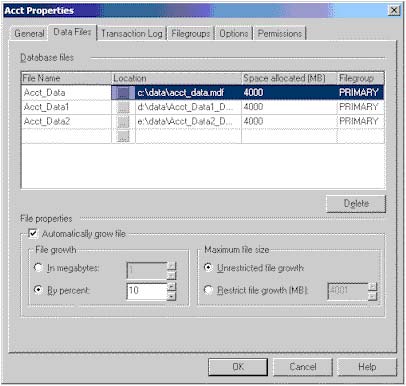
The server has two hard disks that are configured as shown in the Server Configuration exhibit.
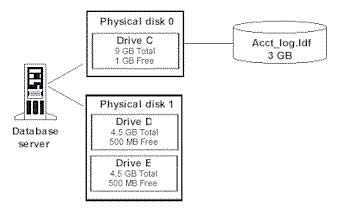
The 3 GB transaction log file for the Acct database is stored on drive C. You need to make room for a new database that has a 3 GB data file and a 1 GB transaction log file. You want to optimize database performance on both databases. You also want to minimize administrative overhead.
What should you do?
A.Shrink the empty data file on drive E. Place the new data file and the new log file on drive E.
B.Shrink the empty data file on drive E. Backup and shrink the log file on drive C to 2 GB. Place the new data file on drive E and the new log file on drive C.
C.Shrink the data file on drive D to 1 GB, and then shrink the data file on drive E to 2 GB. Place the new data file on drive D and the new log file on drive E.
D.Shrink and delete the data file on drive C, and then shrink the database files on drives D and E so that they are both 2 GB. Place the new data file and the new log file on drive C.
第1题:
You are the administrator of a SQL Server 2000 computer. The server contains database named Sales. Users report that they cannot add new data to the database. You examine the properties of the database. The database is configured as shown in the Sales Properties exhibit.
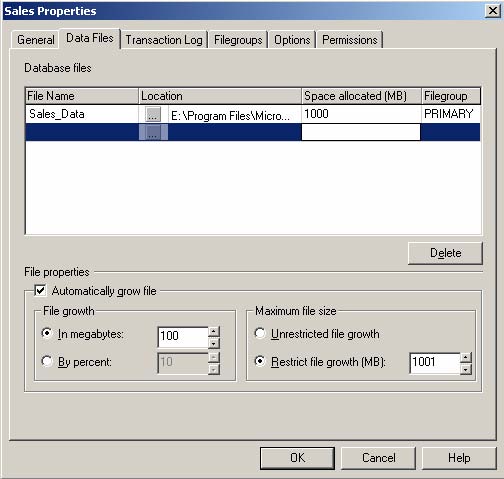
You examine drive E. The hard disk is configured as shown in the Local Disk Properties exhibit.
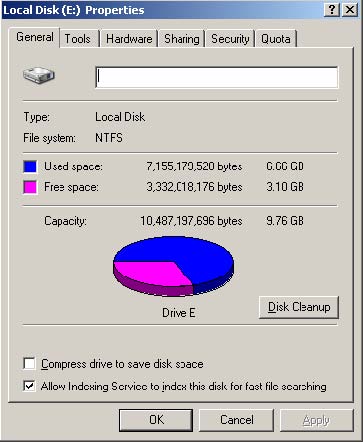
You want the users to be able to add data, and you want to minimize administrative overhead. What should you do?
A.Increase the maximum file size of Sales_Data to 1,500MB.
B.Use the DBCC SHRINKDATABASE statement.
C.Set automatic file growth to 10 percent.
D.Create another data file named Sales_Data2 in a new SECONDARY filegroup.
第2题:
You are the administrator of several SQL Server 2000 computers. You want to retrieve information from an archived inventory database. You have a full tape backup of the database. The backup’s header information shows that the backup uses the SQL_Latin1_General_CR437_BIN collation.
However, the existing SQL server computers in your office are configured to use the
SQL_Latin1_General_CP1_CI_AS collation.
You do not want to join tables in the inventory database with tables in other databases. You need to restore the inventory database to a SQL Server 2000 computer by using the least amount of administrative effort.
What should you do?
A.Use the rebuildm utility to rebuild the system database on an existing SQL server computer. Configure all the databases on that server to use the SQL_Latin1_General_CR437_BIN collation. Restore the inventory database to the server.
B.Restore the inventory database to an existing SQL server computer. Accept the SQL_Latin1_General_CR437_BIN collation for that database.
C.Install a new named instance of SQL Server 2000 on an existing SQL Server 2000 computer. Configure the named instance to use the SQL_Latin1_General_CR437_BIN collation. Restore the inventory database to the named instance.
D.Install SQL Server 2000 on a new computer. Configure the new server to use the SQL_Latin1_General_CR437_BIN collation. Restore the inventory database to the new server.
第3题:
You are the administrator of two SQL Server 2000 computers. One of these servers contains a 4-GB database named marketing. You want to remove the marketing database from one server and add it to the other as quickly as possible.
What should you do?
A.Detach the database from the original server by using the sp_detach_db stored procedure. Copy the database and the transaction log files to the new server, and attach them by using the sp_attach_db stored procedure.
B.Use the DTS export wizard to transfer all database objects from the original server to the new server. Drop the database from the original server.
C.Run a full backup of the database on the original server. Create a new database named marketing on the new server. Restore the backup in the new marketing database. Drop the database from the original server.
D.Shut down the original server. Copy the database and the transaction log files to the new server. Use the DISK INIT and DISK REFIT statements to attach the data file to the new server. Drop the database from the original server.
第4题:
You work in a company which is named Wiikigo Corp. The company uses SQL Server 2008. You are the administrator of the company database. Now you are in charge of a SQL Server 2008 instance. There is a SQL Server 7.0 database. You upgrade the database to the SQL Server instance. According to the company requirement, you must make sure that suspect pages can be detected in the database. So what action should you perform to achieve this goal?()
第5题:
You work in a company which is named Wiikigo Corp. The company uses SQL Server 2008. You are the administrator of the company database. Now you are in charge of a SQL Server 2008 instance. There is a database named Dworks in the instance. Now you get a report from users saying that DB1 meets deadlock problems. As the technical support, you have to capture the deadlock information to the SQL Server error log. What should you do?()
第6题:
You are the administrator of SQL server 2000 computer. The server contains a database named MedicalRecords. Users access medical records by using the PatientID field. This field is the clustered primary key for the Patients table. When users try to access medical records, the database responds slowly. You examine the database options as shown in the exhibit.
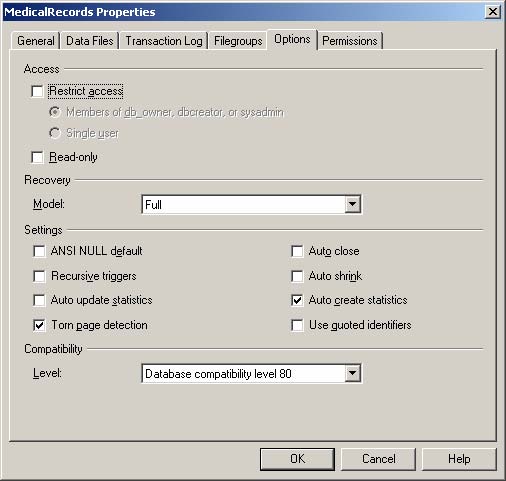
You want to accelerate query response time and minimize administrative overhead. How should you reconfigure the database?
A.Create a SQL Server Agent job to execute the UPDATE STATISTICS statement, and schedule the job to run weekly.
B.Select the Auto Update Statistics check box.
C.Run the database maintenance plan wizard, and accept the default settings.
D.Rebuild the primary key as a nonclustered primary key.
E.Clear the Auto Create Statistics check box.
第7题:
You work in a company which uses SQL Server 2008. You are the administrator of the company database. Now you are in charge of a SQL Server 2008 instance. There is a database named DB1 in the instance. When you are absent, a user will use a login named Mary to log in and maintain the database snapshots. The user has to delete the database snapshots for DB1, so you have to give the appropriate permissions to the user. So which database permission should you give the user?()
第8题:
You are the administrator of a SQL server 2000 computer that contains a database named Acct. The database contains 1.5 GB of data. The server has one 9-GB hard disk that is configured as shown in the Exhibit.
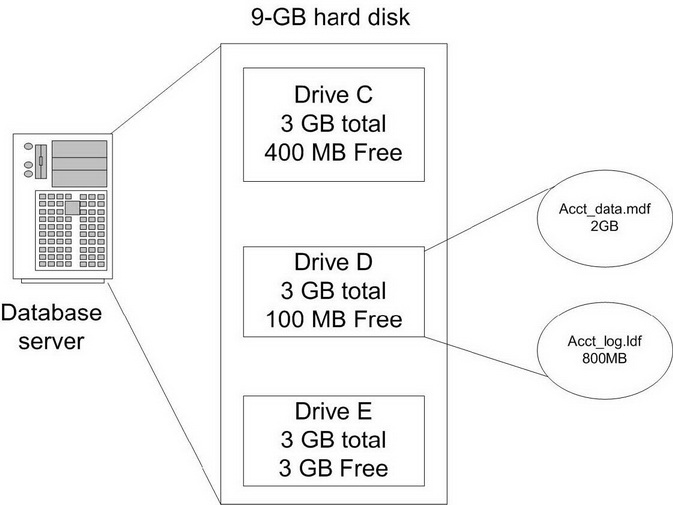
You need to import data into the database without adversely affecting database performance. The data will require an additional 2GB of storage space.
What should you do?
A.Add another data file on drive E, and then add the file to the PRIMARY filegroup.
B.Move the transaction log file to drive E, and set the file growth of Acc_Data.mdf by selecting the Unrestricted file growth option.
C.Rebuild all clustered indexes so that they have a fill factor of 100.
D.Compress drive D.
第9题:
You work in a company which is named Wiikigo Corp. The company uses SQL Server 2008. You are the administrator of the company database. Now you are in charge of a SQL Server 2008 instance. There is an internal application which uses Analysis Services and Reporting Services. You use the application on the basis of SQL Server 2008. According to the requirement of company security policy, the surface area for all the deployed components of SQL Server 2008 should be configured. You have to implement the security policy and devise a method to evaluate the security policy against other database servers. What should you do?()
第10题:
You work in a company which uses SQL Server 2008. You are the administrator of the company database. Now you are in charge of a SQL Server 2008 instance. There is a database named DB01 in the instance. The company CIO wants all the application developers can capture traces to troubleshoot the application that uses the database DB1, and they can perform this by using SQL Server Profiler. But they have to be given as little permission as possible. The company CIO assigns this task to you. So what action should you perform to achieve this goal?()